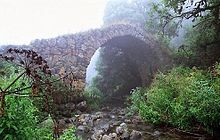Kapan
[6] The area of modern-day Kapan was first mentioned in the 5th century as a small settlement within the properties of the Siunia dynasty.
As the capital of the Kingdom of Syunik, Kapan flourished throughout the 11th century, reaching around 20 thousand inhabitants, composed of mostly Armenians with a prominent Jewish minority, and being a center of trades, crafts, and metallurgy.
The medieval Armenian historian Stephen Orbelian of Syunik states that the Seljuks began massacring from the Jewish quarter of Kapan.
In 1722, the Armenian principality of Kapan was established by uniting the noble families of Syunik into one state in order to fight against Muslim oppression.
David Bek started his battles in 1722 with the help of thousands of local Armenians, including Avan Yuzbashi and Mkhitar Sparapet, taking control of Syunik.
[citation needed] In 1813, the territory of historic Syunik, including the region of Kapan, officially became part of the Russian Empire as a result of the Russo-Persian War of 1804–13 and the following Treaty of Gulistan signed between Russia and Iran.
By the last quarter of the 19th century, Kapan formed an important urban community for the region as a result of merging several villages together.
[14][15] Following the independence of Armenia in 1991, Kapan became the centre of the newly formed Syunik Province as per the 1995 administrative reforms of the republic.
During the First Nagorno-Karabakh War, Kapan was bombarded by artillery coming from the neighboring Zangilan District of Azerbaijan, causing deaths among the civilian population.
[16] Kapan is the largest town in the Syunik province as well as the entire region of southern Armenia.
It is located in the eastern part of Syunik, within the narrow valley of the Voghji River with a length of 13 km (8 mi) from the east to the west, at the southeastern slopes of the Zangezur Mountains, between the Bargushat and Meghri ridges.
Kapan has a humid continental climate (Köppen Dfb) with very warm summers and cold winters.
The fauna of Shikahogh has not been fully explored, but studies have revealed rare species of animals such as leopard, wild goat, bear, viper, and hedgehog.
[7] During the first half of the 19th century, many Russian and German engineers and workers arrived in Kapan to work in the copper mines of the region.
As one of the historic settlements of Armenia, Kapan and the surrounding areas are home to many heritage monuments of Armenian architecture, including:[8] The town has several statues of prominent Armenian patriotic figures, such as the equestrian statue of Davit Bek erected in 1983, and Garegin Nzhdeh's memorial opened in 2001.
The M-2 main road that connects the capital Yerevan with southern Armenia and the Iranian border passes through Kapan.
[citation needed] Prior to the First Nagorno-Karabakh War, the nearby airport accommodated the YAK-40 and AN-14 cargo aircraft.
In February 2017, the governor of Syunik Province, Vahe Hakobyan, announced that the airfield would become a modern airport serving the town of Kapan and southern Armenia, and on June 6 a test landing was conducted at the airfield with the governor on board.
It is currently working the Shahumyan deposit and produces around 65,000 ounces of gold equivalent in copper and zinc concentrates per year.
[citation needed] In May 2013, Gandzasar Kapan opened their football pitches, including one with artificial turf.
[32] Kapan is also home to the Davit Hambardzumyan Children and Youth Sport School, operated by the municipality since its inauguration in 1969.











